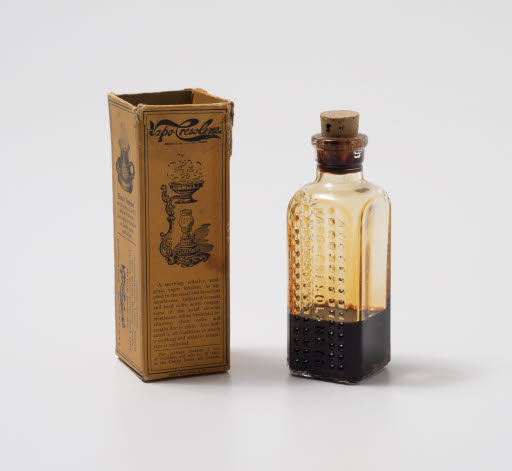Collections
| Back New Search Tips |
Vapo-Cresolene Bottle and Carton

|
| Accession #: | 2825.53 |
|---|---|
| Title: | Vapo-Cresolene Bottle and Carton |
| Object Type: | Bottle, Medicine |
| Participants: | |
| Physical Description: | A clear, pressed glass pharmaceutical bottle is contained within a cardboard carton. The bottle has a flat, square base with a slight round indentation in the middle. The sides are straight and then indent to form sloping shoulders that blend into a .75 neck forming a diameter with an extending lip at the rim. There is a cork stopper in the opening of the bottle; the side is printed with words Vapo-Cresolene Co. in relief. Opposite side is printed with patent information. The cardboard carton is yellow-orange in color; printing is in black: Vapo-Cresolene Registered Trade mark. There is a black and white drawing of a vaporizer, underneath which is a description of what the medication is for. The right side gives further information on the medication: "Cresolene has been used since 1897 for the relief of the conditions for which it is recommended." The back gives the dosage and the left side describes the Electric Vaporizer. The bottom gives prices: 2 oz. 30 cents, 4 1/2 oz. 60 cents 16 oz. $1.75. |
| Description: | Spokane was not spared the 1918 worldwide Spanish Influenza. The first nationwide case was reported on October 1, but no alarm was sounded. The outbreak spread like wildfire, reaching 42 states within two days and Washington State within a week. Dr. John B. Anderson, City Health Officer, warned that "methods used to fight pestilence in medieval times, such as bonfires, burning spices, or salt or vinegar sprinkled on flames, were useless." However "spirit lamps" used in private homes vaporized medicine for just that purpose. By October 8th all Spokane public gathering places were closed, including courts and stock exchange. Weddings, funerals, and church services were banned, and rules were strictly enforced regarding ventilation, sanitation, and spitting. The community rallied and established an influenza hospital in the Lion Hotel. Red Cross volunteers made gauze masks, and public health visiting nurses provided aid to families. Farmers donated food, and many doctors and nurses served without pay. Citizens wore masks everywhere, and morticians worked overtime to remove the dead and maintain burial services. The epidemic forced a ban on singing at Christmas church services before it finally ended in January 1919. Compared to other cities, Spokane's suffering was modest; only 1045 deaths among nearly 17,000 influenza cases. |
| Category: | History |
| Subjects/Topics/Concepts: |
Medicine (Industry), Pharmaceutical (Industry->Medicine)
|
| Geographical Reference: | Spokane (Washington->Spokane County) |
| Dimensions: |
Object H x W x D 4 1/4 x 1 3/8 x 1 3/8"
|
| Materials/Techniques: |
glass (Material)
cork (Material)
cardboard (Material)
|
| Marks/Inscription: |
37 Lombard Street, London, England Miles Building, Montreal, Canada 411 Smith Street, Durban, South Africa 543 peru, Buenos Aires Vapo-Cresolene Co., 62 Cortlandt Street, New York, N.Y. U.S.A.
|
| Credit Line: | Gift of Mark Preston, 1982 |
To order a reproduction, inquire about permissions, or for information about prices see:
https://www.northwestmuseum.org/collections